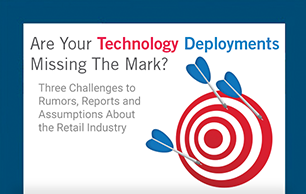 In the previous article, we talked about how interactive gives retailers staying power by building the strength and relevance of their brands and increasing the connection with their customers. In this article, we'll deep-dive into specific use-cases for interactive technologies and how these tactics truly transform your brick-and-mortar stores. “A Tale of Two Retailers” presents a picture of a specialty retail store “before” and “after” the deployment of interactive technologies.
In the previous article, we talked about how interactive gives retailers staying power by building the strength and relevance of their brands and increasing the connection with their customers. In this article, we'll deep-dive into specific use-cases for interactive technologies and how these tactics truly transform your brick-and-mortar stores. “A Tale of Two Retailers” presents a picture of a specialty retail store “before” and “after” the deployment of interactive technologies.
Old Store: Waiting For Traffic
Perhaps your retail store relied on advertisements, promotions or simply customers’ loyalty to draw foot traffic to the store. Visits to the mall on a lazy Sunday afternoon might find shoppers browsing or running to your store to pick up something the kids need for school, a gift for a friend, or a dress for an upcoming event. But given the speed of life in the digital age and the fast, convenient availability of online shopping, your loyal shoppers may simply hop on Amazon to order what they need online. With nothing but shelves of merchandise, a visit to your store may have just lost its place on your customer’s priority list.
Newly Transformed Store: Engaging Consumers
Your digitally transformed store features a massive video wall just inside the store where it can be seen from outside. Engaging videos attract the attention of passers-by who are drawn into the store to see more. Loyal customers may hear about the cool new displays on social media or by word-of-mouth, moving a visit to your store up on their priority list.
Old Store: In-and-Out
Once in the traditional store, hurried shoppers make a beeline toward that single item they need, shuffle through some sizes, maybe hit the dressing room quickly, and then they’re off to the checkout line to make their purchase and move on with their to-do list.
Newly Transformed Store: Increasing Linger Time
Interactive stores have an allure that brings comfort and happiness to shoppers with mood-lifting background music delivered via store-wide audio and interesting content delivered via kiosks. Other inviting experiences may include in-store restaurants, coffee shops or bars, try-the-merchandise counters that make shoppers feel welcome and comfortable in interactive environments, encouraging them to stay in-store and relax. An increase in linger time can result in greater revenue per customer.
Old Store: Thanks and Good-bye
In the old store, cashiers may bid shoppers a friendly good-bye and the retailer might even follow-up with a coupon to use online or in-store. This serves as a token of the retailer’s appreciation for the customer’s business as well as an incentive to return to the store. However, the approach is still one-size-fits-all and is often set aside by the shopper.
Newly Transformed Store: Become a Friend
Interactive stores don’t deliver a token of their appreciation, but rather extend the opportunity to establish a relationship with their retail store. Interactive payment kiosks offer shoppers quick and easy enrollment in loyalty programs. The retailer may deliver at that moment, or as a follow-up communication, an invitation to a special members-only event. They may also use data on what the shopper purchased or what they looked at to notify them when an item of interest goes on sale or when the newest version of the running shoe they just purchased is released. By delivering relevant information and personalized promotions on a regular basis, the digitally transformed specialty retailer can establish true relationships with customers that keep them coming back for more.
If your store sounds more like the old, traditional store than the newly digitally transformed one, then some strategically placed interactive technologies may help you take your store to the next level.




